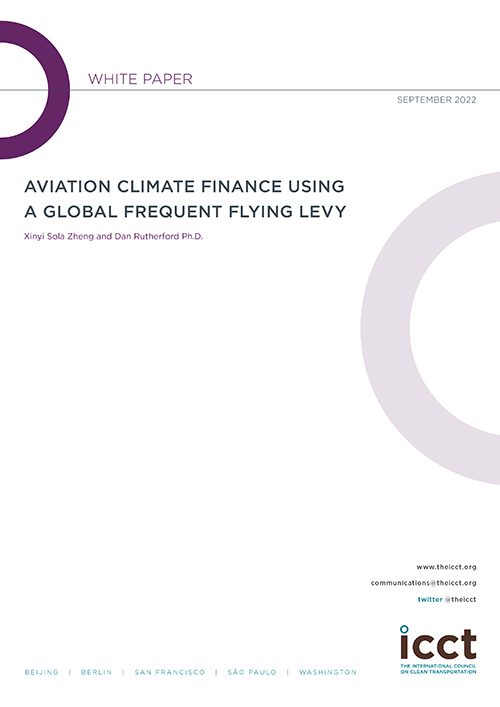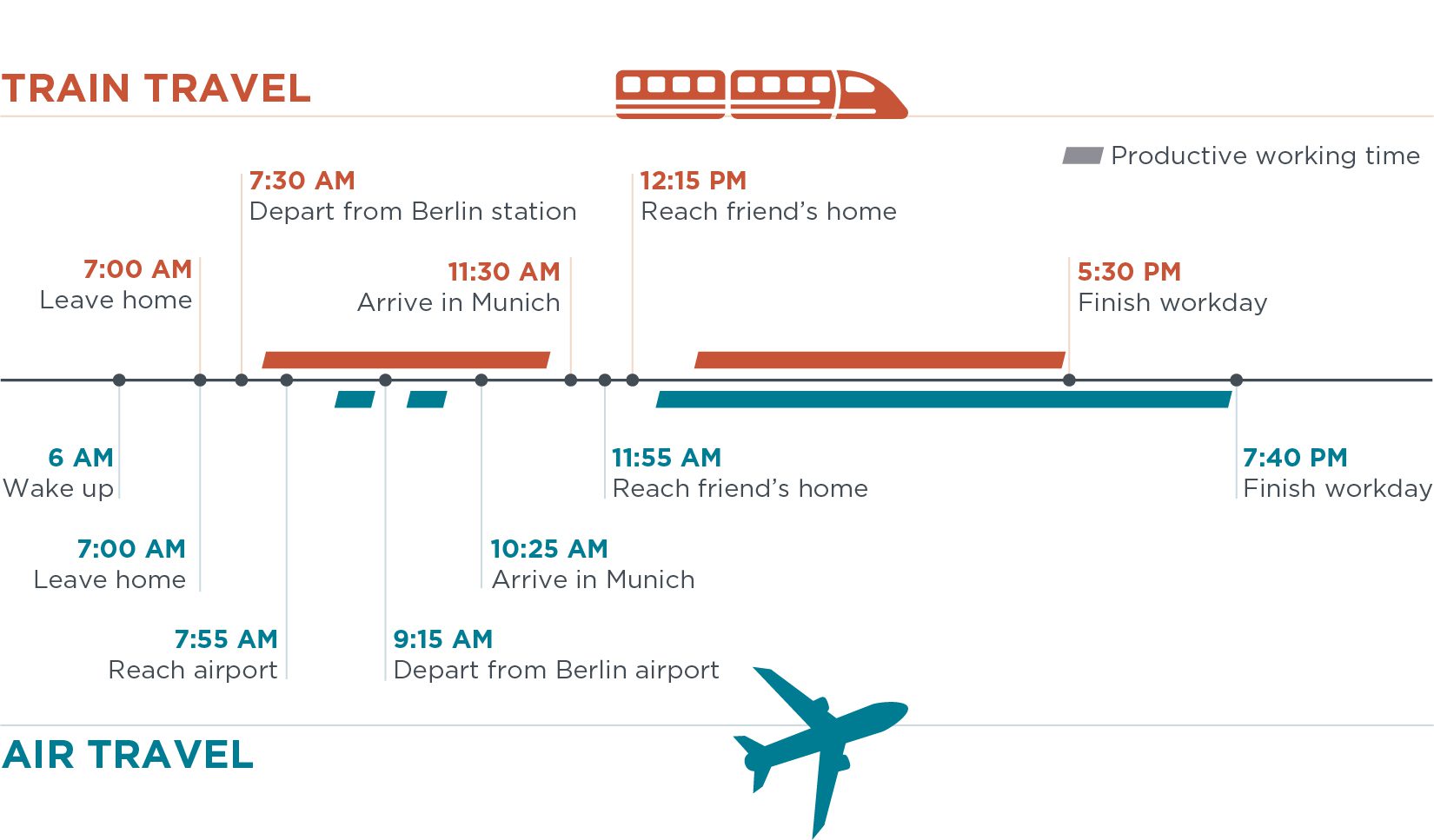Aviation climate finance using a global frequent flying levy
Blog
An aviation researcher’s ode to the train
I’m an aerospace engineer and spend my days working on decarbonizing commercial aviation. I’ve also fallen in love with European trains. Not only are trains the more sustainable transport option of the two, but they can often save time when compared to short-haul flights. Indeed, focusing solely on the speed of an airplane can mask the time cost of airport logistics, and I’ll illustrate this using the example of my recent trip from Berlin to the Bavarian Alps.
I took the 8:05 a.m. train from Berlin to Munich, a 464 km journey, and the timeline is compared to a hypothetical one in which I fly in Figure 1. For illustrative purposes, I shifted the departure times for the flight and train such that I would have to leave home at the same time to use either mode: 7 a.m. I also assume that public transport is taken to and from the airports and train stations. The two timelines start diverging quickly because it takes me 30 minutes longer to get to the airport than to the train station; then I have to spend an hour longer at the airport before takeoff because of check-in, security, and boarding procedures. Still, the 1 hour and 10 minute flight is quicker than the 4-hour train ride and puts me at the Munich airport about 1 hour earlier than I reach the Munich train station. However, the flight’s speed advantage is down to only 20 minutes by the time I reach my final destination, my friend’s home.
Figure 1. Example timeline for the author’s travel between Berlin and Munich by train (top) and by airplane (bottom).
Now let’s add the dimension of a workday. I traveled on a Thursday for my friend’s wedding ceremony on Friday. Instead of taking the day off, I did a full 8 hours of work remotely (writing this blog post, actually). I worked for about 3.5 hours during my 4-hour train journey and then had 4.5 hours left. Had I instead been on the flight, I could perhaps have snuck in 30 minutes of work between security and boarding and another 30 minutes while the airplane was cruising. That would have left me with 7 hours of work remaining when I got to my friend’s home. Even with the 20-minute head start after the flight, taking the train allowed me to finish my workday more than 2 hours earlier than the flight would have. That’s 2 quality hours with my friend that I spent biking along the Isar River and enjoying Bavarian beer at a nearby brewery.
Given the above timeline, even a 6-hour train journey could be preferable to a flight for certain travelers. And now the environmental benefits are beginning to be acknowledged in regulations. As part of its Climate and Resilience law, France banned short-haul domestic flights between cities that had an existing train connection that takes less than 2.5 hours. The requirements for qualifying railway connections are pretty stringent, though, and thus the ban only applies to three domestic routes that are less than 2% of mainland France’s domestic aviation market in terms of passenger kilometers flown. Extending the ban to cities with train connections of up to 6 hours would cover high-traffic routes between Paris, Toulouse, Marseille, and Nice. Such an extension could curb more than 50% of mainland France’s domestic aviation market.
In Germany, because of the extensive train system, implementing a ban where there are train connections of up to 6 hours could curb nearly 90% of domestic air travel. Germany is roughly two-thirds the size of France and its railways transported about twice the number of passengers in 2021. According to Deutsche Bahn, its high-speed rail is entirely powered by renewable energy and emitted 1.4 grams of carbon dioxide equivalent (gCO2e) per passenger kilometer in 2021. This is a 99% reduction in emissions intensity compared to German domestic aviation, which was estimated to be 110 gCO2e per passenger kilometer in 2019. By instating a ban on short-haul flights, Germany could reduce emissions by 1.5 million tonnes of CO2e, roughly 6% of the emissions from all flights departing German airports.
There are concerns that such regulations could prevent passengers from booking convenient connecting flights to their final destination. However, airlines could follow Lufthansa’s lead and help passengers book a train connection instead of a flight connection. I once used this to take a train to Frankfurt to board a flight to New Delhi, and it resulted in 13% fewer emissions compared to flying the entire way. This approach is not perfect—I was once stranded in Frankfurt when a flight delay made me miss the last train to Berlin that day—but the same could’ve happened with a flight connection.
Trains are a more sustainable alternative to flying but their expansion requires more ground-based infrastructure than building new airports. There are recent success stories, though. For one, the rapid rollout of the high-speed rail network in China has made train travel competitive with flights on journeys of 1,300 km and longer. The European Union has adopted a target to double high-speed rail traffic by 2030 and is supporting it with an action plan that includes things like increasing infrastructure investment and harmonizing ticketing across the European Union. Learning from France, the European Union should consider short-haul flight bans as a tool in its arsenal to increase rail travel.
Even setting aside the environmental benefits, trains bring me more joy than flights. I don’t have to stress about the size of my toiletries or whether my boots will put my bag over the weight limit. I can bring my bike and I don’t have to fear being randomly selected for additional security checks (I am a brown man who often travels alone, after all). Trains are not just a more sustainable alternative to flying. Over short distances, it’s possible for trains to reduce overall travel time. In the absence of regulations restricting short-haul flights, it will be up to individuals to choose to take the train instead of flying. My advice? Next time you’re in Europe and if connectivity allows, take a train.
Author
Related Publications

AVIATION CLIMATE FINANCE USING A GLOBAL FREQUENT FLYING LEVY
Analyzes the potential of a tax on individuals who fly often to raise revenue for the decarbonization of aviation


